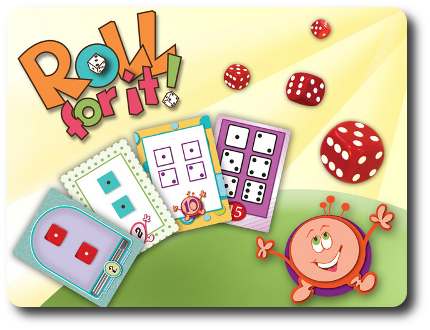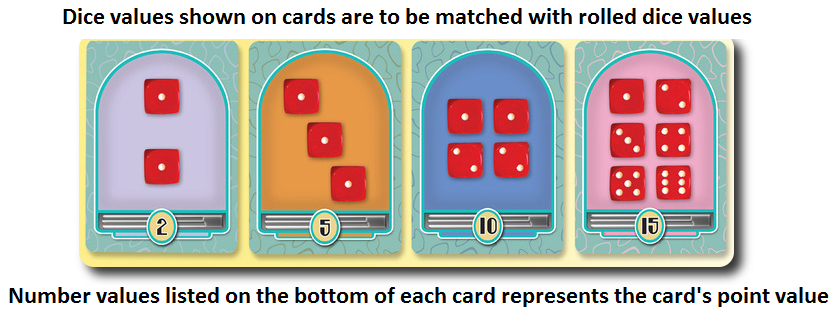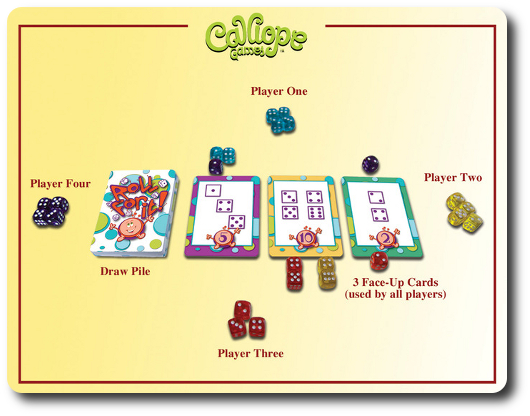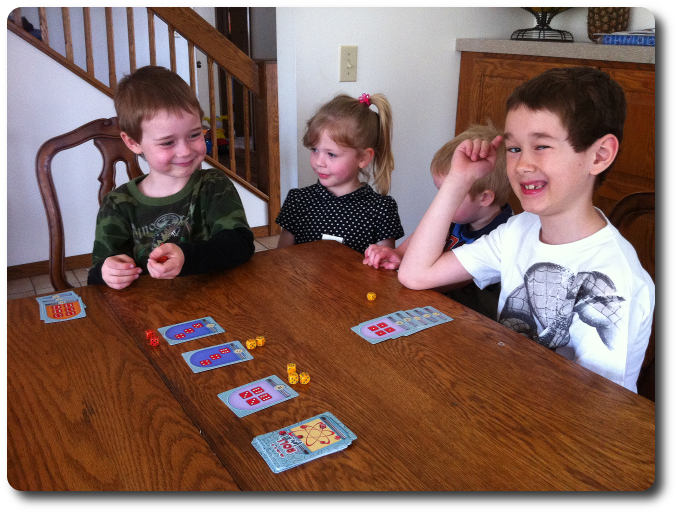Please Take Note: This is a review of the game’s final prototype. The art, game bits, and the rules discussed are all subject to change. The game is being reviewed on the components and the rules provided with the understanding that “what you see is not what you might get” when the game is published. If you like what you read and want to learn more, we encourage you to visit the game’s official web page (where you can play the game online) or visit the game’s Kickstarter campaign. Now that we have all that disclaimer junk out of the way, on with the review!

The Basics:
- For ages 5 and up (publisher suggests 8+)
- For 2 to 4 players
- Approximately 20 minutes to complete
Geek Skills:
- Counting & Math
- Logical & Critical Decision Making
- Pattern Matching
- Risk vs. Reward
- Hand/Resource Management
Learning Curve:
- Child – Easy
- Adult – Easy
Theme & Narrative:
- None
Endorsements:
- Gamer Geek rejected!
- Parent Geek approved!
- Child Geek approved!
Overview
Dice and cards go together like chocolate sauce and vanilla ice cream. When paired, these two different mediums of game play can make for some sweet entertainment. The latest combination takes the random number values of dice and blends it seamlessly with cards that must be matched for every value rolled. Luck and logical thinking go hand-in-hand in this game of risk, reward, and fun!
Roll for It, designed by Chris Leder and to be published by Calliope Games, will reportedly be comprised of 30 cards and 24 standard six-sided dice (in 4 different colors, 6 dice each). As this is a review of a prepublished game, we will not comment on the game component quality, but what we were provided was durable and looks to be the same quality as most published games. OK, I guess we just commented on the component quality…
Getting Ready to Roll
To set up the game, first take the cards and shuffle them all together. Place the deck face-down to one side of the playing area and then draw the top 3 cards off the top. Place these cards in a continuous row next to the draw deck and leave enough room so players can place their dice around them.
Second, separate the dice into different sets. Each dice set will be comprised of 6 six-sided dice of the same color. Players take the set of their choice and place the dice in front of them.
Third, each player takes 2 six-sided dice and rolls them. The player with the highest combined rolled value goes first. Reroll any ties.
That’s it for game set up! Let’s play!
Rollin!
The game is played in turns with no set number of rounds. A player’s turn is comprised of 3 different steps. These steps are summarized here.
Step 1: Roll for It!
If this is the player’s first turn, they will take all 6 of their dice and roll them. As the game progresses, the player will have at times less than 6 total dice to roll. However, on the first step of their turn, the player can reclaim all the dice they have currently played, taking them off cards they are attempting to claim, to once again have a complete set of 6 dice to roll. By doing so, they lose whatever values they had towards other cards, but gain the ability to roll a full set again. This is a great way for a player to pull back all their dice when they suddenly find themselves in a corner.
Step 2: Match It!
The player now takes any dice they just rolled and matches them to the dice values shown on the cards. Each card will have a minimum of 2 and a maximum of 6 different number values to match. If the player wants to place one or more of their dice in an attempt to claim the card, they simply take the die or dice they want to attach and place it next to the card they want to claim. Caution should be taken at this point. Each time a player places a die around a card they are attempting to claim, the die becomes “locked” and cannot be removed unless all the dice are taken back by the player during the first step.

Step 3: Score It!
The player now reviews the cards to see if any of the dice values they have placed match all the numbered values on the card. If they do, the card is scored, taken from the row, and placed in front of the player with the score value showing. Any dice attached to that card are returned to their owners. The player who just claimed the card cannot use the dice that won them the card until their next turn.
The empty space in the row is automatically refilled by taking the top card off the deck and flipping it over to reveal the new card to be contested over.
If none of the dice currently attached on the cards score a card, they remain “locked” and the player takes any remaining dice that are not attached back. The player’s turn is now over and the next player in turn order sequence goes starting with step 1 above.

An example of a game in progress
Note that all the players are competing for the same cards at the same time. Players only score a card when their dice match the card’s values, not combining their dice values and their opponents’ dice values.
Winning the Game
The game continues until a player has claimed cards with a combined total of 40 or more points. Points for each card are noted at the bottom.
Expanding the Game
Roll for It is expandable…probably indefinitely. The base game of 30 cards and 26 dice can only accommodate a total of 4 players. All that is needed to jump from a maximum of 4 players to 8 is another deck of cards and another 26 dice. Different colored dice and different designed decks are available for purchase if your family and friends ever want to play the game as a really big group. The base game rules only allow for 3 cards to be revealed at a time, while expanding it with another deck changes it to 4 cards being revealed. Game set up and game play is the same with the only difference being a slightly longer game and a bit more downtime between rolls.
To learn more about Roll for It, visit the game’s official web page or visit the game’s Kickstarter campaign.
Prediction
Sometimes all you want to do is play a simple game where everyone can just focus on having fun together. Many games in this wonderful hobby of ours will pit player against player in mental matches where victory is only won through complex game tactics and indepth strategy. A Thunderdome for the mind, if you will. Roll for It is no Thunderdome. I’d say it’s more akin to a low hanging jungle gym – enough to keep everyone occupied, but nothing much in the way of complexity. Games like Roll for It are perfect for families and for the non-gamers because the pretext of getting together is further strengthened by a simple game that was only ever intended to get family and friends to play together in the first place.
Given this, I believe Roll for It will do very well with the Child and Parent Geeks. I don’t see anything at all to suggest this casual game of luck and dice management will be anything other than approved and thoroughly enjoyed. History has already shown us that games like Roll for It play well with mixed age and skill groups. You don’t have to look very deep into Roll for It to see common game mechanisms that have and continue to work very well with family and non-gamers.
But for the Gamer Geeks, I don’t see much in Roll for It to keep them interested. The game is all about luck. Yes, there is a light element of dice management, but before a player need exercise any level of critical and logical thinking into what they rolled, they have to roll values that match the same values on the cards. This is nothing more than a simple pattern matching exercise to the gamer elitist and that is seldom enough to keep them happy.
Teaching the game can be done in about 2 minutes. All I did was draw the first three cards, rolled two sets of dice, and demonstrated how the rolled results were attached to cards. I then demonstrated how the next two turns would go (manipulating the dice to help facilitate my examples) to show how scoring was done and how the game progressed. None of the players we taught the game to had any questions and felt very confident they could play the game after just a brief demonstration. And so, as I shuffled the cards and my two oldest little geeks took their dice in hand, I asked them their thoughts on Roll for It so far.
“An easy game of dice rolling and card collecting. We’ve played games like this before. I’m totally going to win.” ~ Liam (age 8)
“Nuh-uh, Liam! I’m going to win! I have more luck than you!” ~ Nyhus (age 5)
While not in the rule book, I wonder if I get any additional points for rolling my eyes at my children’s’ table banter. Looks like my two little geeks are ready to shake up their dice and collect cards. Let’s see if Roll for It is a keeper or I’ll be rolling it out the door.
Final Word
Roll for It scored very high with the Child Geeks. They loved the game’s feel and game play as they rolled dice, collected them, re-rolled them, and so on. The younger Child Geeks focused almost entirely on one card at a time, while the older Child Geeks sought to claim several by spreading out their dice. I’m at a loss to suggest which of two methods would lead to victory faster. While the younger Child Geeks got more points per card, they didn’t collect cards as quickly as their older siblings and peers who focused on easy cards with small point values. Every game was a close one (the point spread difference between the winner of the game and the other players was always slight) making it impossible for me to judge which method of play was the superior strategy. Doesn’t really matter one bit, however, as all the players – win or lose – loved playing it. All the Child Geeks we enjoyed Roll for It with eagerly approved it.

My two oldest little geeks play their second game while two younger Child Geeks look on
The Parent Geeks also enjoyed it, but their level of enjoyment could be measured by their level of past game play experience. For the very casual Parent Geek game player and non-gamers, Roll for It was a smashing success, both at the family and the Parent Geek peer level. For the Parent Geeks who enjoyed more complex games and sought out tactical and strategic game play when time allowed, Roll for It started to lose its luster after the first game was played. In hopes of clarifying what we observed, I asked two different Parent Geeks their thoughts on the game.
“This is a really neat game of rolling dice and claiming cards. I feel like I always have a chance to get points and each turn is fast!” ~ A Casual Parent Geek Game Player
“All I am doing here is rolling dice and assigning them to cards. That’s great for my family and great when I want to play games with other adults in a noisy room, but I don’t see myself playing this game on my own unless I have my family at the gaming table.” ~ A More “Serious” Parent Geek Game Player
Roll for It did well enough with the Parent Geeks to get their approval, but the depth of this game is about 1 game play deep. Once it was fully explored, the more adventurous and experienced Parent Geeks were ready to move on to something else.
As predicted, the Gamer Geek’s didn’t care for Roll for It. Criticism of the game always focused on its repetitive nature, its too simple game play, and high dependence of luck. The Gamer Geeks see this type of game playing as terribly frustrating because there is no way to improve your position in the game other than to simply have more luck than your opponent. Interestingly enough, the Gamer Geeks never once left their dice attached to the cards. They would roll their dice, and if no cards were scored, took them all back. This turned out to be a very inefficient way of scoring cards, but it was a good way to improve one’s odds. Roll, score, rinse, repeat, yawn, snore, next game. To suggest that the Gamer Geeks were less than impressed is putting it lightly. They unanimously agreed to reject Roll for It.
Roll for It is the perfect family game for mixed age groups and skill levels. Everyone can roll dice. Everyone can match die values to card values. Everyone can play this game. But casting such a wide net to capture so many different players always reduces the game’s overall level of difficulty and depth. This simple truth cannot be avoided. Roll for It has been simplified to allow for a low bar of entry, but not brainless game play. Players will need to logically think through their rolls and place their dice where they think they have the best chances of getting points returned. This game introduces and reinforces some very basic Geeks Skills that are used again and again in much more complicate games, making it perfect for raising Child Geeks and to keep more experience players entertained at the table with casual game play.
This game was given to Father Geek as a review copy. Father Geek was not paid, bribed, wined, dined, or threatened in vain hopes of influencing this review. Such is the statuesque and legendary integrity of Father Geek.




Hey Cyrus! I think the review is great, but I have to disagree with you on the Gamer Geek not enjoying this one. For one, I am a Gamer Geek, and this game greatly appeals to me. I love dice (what geek doesn’t) and I love dice games. I love the tactile sensation of a hand full of dice as well as the auditory clatter of the dice hitting the table.I am always looking for dice games to add to my game nights and this will be one of them.
Yes, I understand the arguement that rolling dice is all luck…in fact it’s a regular discussion among my gaming friends(one that is often lost if you challenge my friend who loves statistics). Even my most hardcore, chess playing, strategic boardgame playing friends enjoy the occasional brain-break of a dice throwdown. I know there are some diehards out there (that must have played for this review) who would disagree, but being a Geek Gamer is about having fun playing games. I am a Gamer Geek…and this game is fun!
There is is nothing to “disagree” or “agree” with here. The review contains recorded opinions of individuals based on personal experience. The Child Geeks don’t represent EVERY CHILD, the Parent Geeks don’t represent EVERY PARENT, and the Gamer Geeks most certainly don’t represent you, Chris, or EVERY GAMER.
Some will enjoy Roll for It and some will hate it, but most won’t feel the need to polarize their opinion either way. In the end, it’s just a game. Play it or don’t, agree with a person’s opinions or don’t.
Like I always tell my children, “Listen and respect the thoughts of others, but think for yourself.”
Much thanks for taking the time to read and to comment, Chris! I’m very pleased to hear you will enjoy Roll for It.
Great review. I’m a big fan of Roll for It, although I definitely see where the gamer geeks are coming from–it’s a very light game. We usually play it in between longer games or at the end of the night (short and sweet), and similar to your experiences, the game seems to work best when there’s a good mix of newcomers and experienced players. Kind of scratches an itch in a way that Incan Gold does. Granted, two veeeery different games, but both can be played with a lot of players, and require very little experience.
Curious – Were you sent just the Diner theme, or the others as well?
We were sent the Diner Theme. Great looking cards. I love that retro look. Wanted to drink a milkshake while playing the game.
Thanks for taking the time and to read, sir!
I enjoyed this game when I played it recently at a convention in Green Bay Wisconsin. I disagree that its all luck. there is a defined strategy in all luck base games this is why some people are always winning and others are regular NOT winning. I can see gamers playing this game at tournaments between rounds to pass the time, but No game is just luck otherwise there is no point in playing. There is a deep enough strategy here to merit it a geek approval. Roll for it “This Gamer Geek approves”
Very pleased to hear you are enjoying the game, Scott!
Hey, I was one of the “Gamer Geeks”, as Cyrus likes to call us, that played this game. While I respect everyone’s opinion (except the dumb ones), I gotta say I really disagree with anyone who says this game is strategic or a Gamer Geek game. It’s not people. It. Is. Not. This is a game about rolling dice, hoping you can match it to a card, and then making the simple choice of sticking it to the card or not. The basis of making that choice is simply determining if you have enough dice to capture the card and how many dice your opponent already has on it. That’s not a Gamer Geek game. Hell, I would suggest that’s hardly a game to begin with.
If you are a “gamer” and like to play this game, super good or you, but don’t start saying that this is a “Gamer Geek” game full of stuff it isn’t just because you play this game and a Euro game or two. It’s not the same. Gamer Geeks can enjoy really complicated games and really simple games, but enjoying it does not make it a Gamer Geek game.
I stand by what I said about this game, would only play it again if pushed in a corner, and know there are more interesting an worthwhile dice and card games out there that challenge me a hell of a lot more than this game.
Roll for It is for kids. Roll for It is for families. Roll for It is not for gamers who are looking for a challenge.
Looks like the target site for the game isted above has been comprimised = “visit the game’s official web page”. .. there is a bunch or articles for condos and stuff unrelated to this game.
Thank you very much for bringing the link issue to my attention, Nick. I have corrected it.